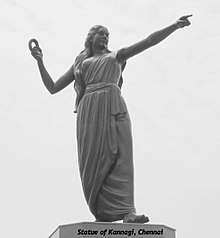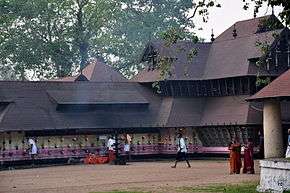Kannagi
| Kannagi | |
|---|---|
 Kannagi Statue in Marina Beach, Chennai |
Kannagi is a legendary Tamil woman who forms the central character of the Tamil epic Silapathikaram (100-300 AD).She is Valaiyar ( Mutharaiyar )community. −The story relates how Kannagi took revenge on the Pandyan King of Madurai, who had wrongfully put her husband Kovalan to death. She cursed the entire town of Madurai. Silapathigaaram tells the story of her revenge and is written by Ilango Adigal.
History

Kovalan was the son of a wealthy merchant of Vaishya community known as Nagarathar community[1][2][3] in Puhar, who married Kannagi. Kovalan met a dancer Madhavi and had an affair with her, which prompted him to spend all his wealth on the dancer. At last, penniless, Kovalan realised his mistake and returned to his wife Kannagi. Kovalan hoped to recoup his fortunes by trade in Madurai, by selling the precious anklet of Kannagi.
Madurai was ruled by Pandya king Nedunj Cheliyan I. When Kovalan tried to sell the anklet, it was mistaken for a stolen anklet of the queen. Kovalan was accused of having stolen the anklet and was immediately beheaded by the king without trial. When Kannagi was informed of this, she became furious, and set out to prove her husband's innocence to the king.
Kannagi came to the king's court, broke open the anklet seized from Kovalan and showed that it contained rubies, as opposed to the queen's anklets which contained pearls. Realizing the fault, the king committed suicide in shame, after having delivered such a huge miscarriage of justice. Kannagi uttered a curse that the entire city of Madurai be burnt. The capital city of Pandyas was set ablaze resulting in huge losses. However, at the request of Goddess Meenakshi, she calmed down and later, attained salvation. The story forms the crux of Silapathikaram written by poet Ilango Adigal.
Worship

Kannagi or Kannaki Amman is eulogized as the epitome of chastity and is worshiped as a goddess in select regions. She is worshiped as goddess Pattini in Sri Lanka by the Sinhalese Buddhists,[4] Kannaki Amman by the Sri Lankan Tamil Hindus and as Kodungallur Bhagavathy & Aatukal Devi in the South Indian state of Kerala. Keralites believe Kannaki to be an incarnation of Goddess Bhadrakali who reached Kodungalloor and attained salvation in the Kodungalloor temple. [5][6]
In popular culture
A Tamil epic film Kannagi directed by R.S Mani released in 1942. This is the first Tamil film based on the epic Silapadhigaaram. A similar second movie named Poompuhar released later in 1964. A statue of Kannagi holding her anklet, depicting a scene from Silapathikaram was installed on Marina Beach, Chennai. It was removed in December 2001 citing reasons that it hindered traffic.[7][8] The statue was reinstalled in June 2006.[9][10]
A Sinhala film called Paththini was released on 5 May 2016 in Sri Lanka. The role of the goddess Paththni or Kannagi was played by Pooja Umashankar.[11]
A famous television serial named Upasana was broadcast on Doordarshan in the early 90's and was based on the twin novels Silappatikaram & Manimekalai.

See also
References
- ↑ chettiar Heritage (2017-06-07), vaniyar - chettiar - Ancient Town | Poompuhar | Kovalan Kannagi | Kaveripoompattinam | Chettiar, retrieved 2017-08-28
- ↑ "Nagarathar children trace their roots". The Hindu. Retrieved 2017-08-28.
- ↑ "Welcome to Nagarathar Ikkiya Sangam". nagaratharikkiyasangam.org. Retrieved 2017-08-28.
- ↑ R.K.K. Rajarajan (2016) Dance of Ardhanārī as Pattinī-Kaṉṉaki: With special reference to the Cilappatikāram. Berliner Indologische Studien, Berlin, Vol. 13/14, pp. 401-14. ISBN 978-3-447-05676-2. https://www.academia.edu/2955548/Dance_of_Ardhanari_as_Pattini-Kannaki_with_special_reference_to_the_Cilappatikaram and R.K.K. Rajarajan (2012) Dance of Ardhanārī. A Historiographical Retrospection. In Tiziana Lorenzetti and Fabio Scialpi eds. Glimpses of Indian History and Art. Reflections on the Past, Perspectives for the Future. Roma: SAPIENZA Università Editrice, pp. 233-270. ISBN 978-88-95814-85-8. https://www.academia.edu/3740760/Dance_of_Ardhan%C4%81r%C4%AB._A_Historiographical_Retrospection
- ↑ Shankar Radhakrishnan HAI Bubbling over with devotion The Hindu news.
- ↑ R.K.K. Rajarajan (2016) Masterpieces of Indian Literature and Art - Tears of Kaṇṇaki: Annals and Iconology of the ‘Cilappatikāram’. Sharada Publishing House, New Delhi. Pages xix + 412, photos 143, ISBN 978-93-83221-14-1. https://www.academia.edu/30222114/Masterpieces_of_Indian_Literature_and_Art_-_Tears_of_Ka%E1%B9%87%E1%B9%87aki_Annals_and_Iconology_of_the_Cilappatik%C4%81ram_
- ↑ "Presidency College ground ideal for Kannagi statue: panel". The Hindu. Chennai: The Hindu. 16 June 2002. Retrieved 9 Oct 2011.
- ↑ "Kannagi statue to be reinstalled on Jun 3: Governor". One India News. OneIndiaNews.com. 24 May 2006. Retrieved 9 Oct 2011.
- ↑ Menon, Jaya (16 May 2006). "On Marina beach, Karunanidhi keeps date with Kannagi". Indian Express. indianexpress.com. Retrieved 9 Oct 2011.
- ↑ Tiwari, Binita (23 August 2007). "Kannagi's statue adorned Marina Beach". Newstrack India. Newstrack India. Retrieved 9 Oct 2011.
- ↑ "Pathini Sinhala Film by Sunil Ariyaratne". Sandeshaya. Retrieved 2 May 2016.
External links
| Wikimedia Commons has media related to Kannagi. |
- R.K.K. Rajarajan (2000) Dance of Ardhanārī as Pattinī-Kaṉṉaki: With special reference to the Cilappatikāram. Berliner Indologische Studien, Berlin, Vol. 13/14, pp. 401-14. ISBN 978-3-447-05676-2.
- R.K.K. Rajarajan (2012) Dance of Ardhanārī. A Historiographical Retrospection. In Tiziana Lorenzetti and Fabio Scialpi eds. Glimpses of Indian History and Art. Reflections on the Past, Perspectives for the Future. Roma: SAPIENZA Università Editrice, pp. 233-270. ISBN 978-88-95814-85-8.
